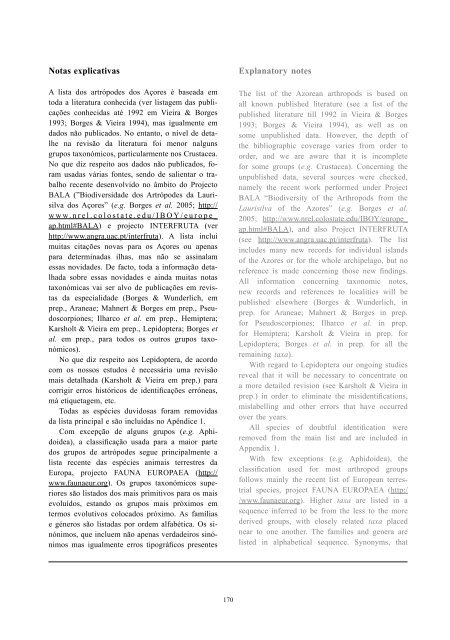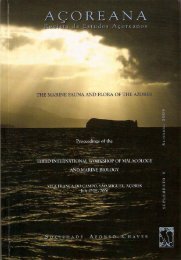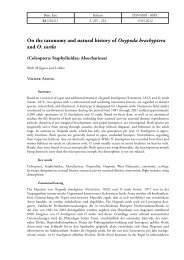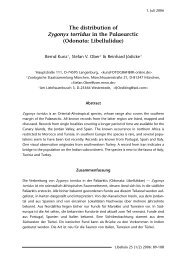(eds.) (2005). - Portal da Biodiversidade dos Açores - Universidade ...
(eds.) (2005). - Portal da Biodiversidade dos Açores - Universidade ...
(eds.) (2005). - Portal da Biodiversidade dos Açores - Universidade ...
You also want an ePaper? Increase the reach of your titles
YUMPU automatically turns print PDFs into web optimized ePapers that Google loves.
Notas explicativas<br />
A lista <strong>dos</strong> artrópodes <strong>dos</strong> <strong>Açores</strong> é basea<strong>da</strong> em<br />
to<strong>da</strong> a literatura conheci<strong>da</strong> (ver listagem <strong>da</strong>s publicações<br />
conheci<strong>da</strong>s até 1992 em Vieira & Borges<br />
1993; Borges & Vieira 1994), mas igualmente em<br />
<strong>da</strong><strong>dos</strong> não publica<strong>dos</strong>. No entanto, o nível de detalhe<br />
na revisão <strong>da</strong> literatura foi menor nalguns<br />
grupos taxonómicos, particularmente nos Crustacea.<br />
No que diz respeito aos <strong>da</strong><strong>dos</strong> não publica<strong>dos</strong>, foram<br />
usa<strong>da</strong>s várias fontes, sendo de salientar o trabalho<br />
recente desenvolvido no âmbito do Projecto<br />
BALA (”Biodiversi<strong>da</strong>de <strong>dos</strong> Artrópodes <strong>da</strong> Laurisilva<br />
<strong>dos</strong> <strong>Açores</strong>” (e.g. Borges et al. <strong>2005</strong>; http://<br />
www.nrel.colostate.edu/IBOY/europe_<br />
ap.html#BALA) e projecto INTERFRUTA (ver<br />
http://www.angra.uac.pt/interfruta). A lista inclui<br />
muitas citações novas para os <strong>Açores</strong> ou apenas<br />
para determina<strong>da</strong>s ilhas, mas não se assinalam<br />
essas novi<strong>da</strong>des. De facto, to<strong>da</strong> a informação detalha<strong>da</strong><br />
sobre essas novi<strong>da</strong>des e ain<strong>da</strong> muitas notas<br />
taxonómicas vai ser alvo de publicações em revistas<br />
<strong>da</strong> especiali<strong>da</strong>de (Borges & Wunderlich, em<br />
prep., Araneae; Mahnert & Borges em prep., Pseu<strong>dos</strong>corpiones;<br />
Ilharco et al. em prep., Hemiptera;<br />
Karsholt & Vieira em prep., Lepidoptera; Borges et<br />
al. em prep., para to<strong>dos</strong> os outros grupos taxonómicos).<br />
No que diz respeito aos Lepidoptera, de acordo<br />
com os nossos estu<strong>dos</strong> é necessária uma revisão<br />
mais detalha<strong>da</strong> (Karsholt & Vieira em prep.) para<br />
corrigir erros históricos de identificações erróneas,<br />
má etiquetagem, etc.<br />
To<strong>da</strong>s as espécies duvi<strong>dos</strong>as foram removi<strong>da</strong>s<br />
<strong>da</strong> lista principal e são incluí<strong>da</strong>s no Apêndice 1.<br />
Com excepção de alguns grupos (e.g. Aphidoidea),<br />
a classificação usa<strong>da</strong> para a maior parte<br />
<strong>dos</strong> grupos de artrópodes segue principalmente a<br />
lista recente <strong>da</strong>s espécies animais terrestres <strong>da</strong><br />
Europa, projecto FAUNA EUROPAEA (http://<br />
www.faunaeur.org). Os grupos taxonómicos superiores<br />
são lista<strong>dos</strong> <strong>dos</strong> mais primitivos para os mais<br />
evoluí<strong>dos</strong>, estando os grupos mais próximos em<br />
termos evolutivos coloca<strong>dos</strong> próximo. As famílias<br />
e géneros são lista<strong>da</strong>s por ordem alfabética. Os sinónimos,<br />
que incluem não apenas ver<strong>da</strong>deiros sinónimos<br />
mas igualmente erros tipográficos presentes<br />
170<br />
Explanatory notes<br />
The list of the Azorean arthropods is based on<br />
all known published literature (see a list of the<br />
published literature till 1992 in Vieira & Borges<br />
1993; Borges & Vieira 1994), as well as on<br />
some unpublished <strong>da</strong>ta. However, the depth of<br />
the bibliographic coverage varies from order to<br />
order, and we are aware that it is incomplete<br />
for some groups (e.g. Crustacea). Concerning the<br />
unpublished <strong>da</strong>ta, several sources were checked,<br />
namely the recent work performed under Project<br />
BALA “Biodiversity of the Arthropods from the<br />
Laurisilva of the Azores” (e.g. Borges et al.<br />
<strong>2005</strong>; http://www.nrel.colostate.edu/IBOY/europe_<br />
ap.html#BALA), and also Project INTERFRUTA<br />
(see http://www.angra.uac.pt/interfruta). The list<br />
includes many new records for individual islands<br />
of the Azores or for the whole archipelago, but no<br />
reference is made concerning those new findings.<br />
All information concerning taxonomic notes,<br />
new records and references to localities will be<br />
published elsewhere (Borges & Wunderlich, in<br />
prep. for Araneae; Mahnert & Borges in prep.<br />
for Pseu<strong>dos</strong>corpiones; Ilharco et al. in prep.<br />
for Hemiptera; Karsholt & Vieira in prep. for<br />
Lepidoptera; Borges et al. in prep. for all the<br />
remaining taxa).<br />
With regard to Lepidoptera our ongoing studies<br />
reveal that it will be necessary to concentrate on<br />
a more detailed revision (see Karsholt & Vieira in<br />
prep.) in order to eliminate the misidentifications,<br />
mislabelling and other errors that have occurred<br />
over the years.<br />
All species of doubtful identification were<br />
removed from the main list and are included in<br />
Appendix 1.<br />
With few exceptions (e.g. Aphidoidea), the<br />
classification used for most arthropod groups<br />
follows mainly the recent list of European terrestrial<br />
species, project FAUNA EUROPAEA (http:/<br />
/www.faunaeur.org). Higher taxa are listed in a<br />
sequence inferred to be from the less to the more<br />
derived groups, with closely related taxa placed<br />
near to one another. The families and genera are<br />
listed in alphabetical sequence. Synonyms, that

















